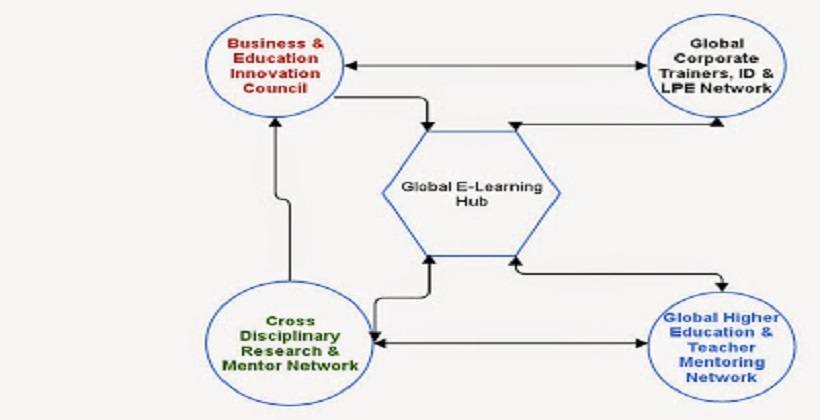Instructional Design: Going Global With The Cloud
In an earlier article titled "SME's: Evolution or Revolution in a Post-Pandemic World," I hinted at a coming reality that due to the effect of exponential growth in cross-discipline knowledge, advancing technology, and the pandemic, our traditional ways of handling change management within our business organizations need to change. Over 20 years ago, the Peter Drucker Foundation, in a great book titled The Organization of the Future (2000), predicted that the day would come when we could no longer act like "deer caught in the headlights" when it came to managing change.
Peter Senge, in a later work titled The Fifth Discipline: The Art and Practice of the Learning Organization (2006), pointed out that business organizations needed to be proactive in making sure that their organizations focused upon ongoing learning as a key priority for a healthy future business organization. The day that they predicted would come is now here. We are faced with the question: Are we still the deer in the proverbial headlights still fearing change, still acting reactively instead of planning proactively?
The Cloud Evolves
If, as a result of the pandemic, business organizations and their employees are placed in the position where 99% of what they do must be conducted in the online environment, what does this mean for all those who are tasked with providing effective, engaging, and efficient learning experiences for their employees? The priority, of course, is to provide continuing advancement in the knowledge and skill level of employees, which should translate into higher performance metrics for the workforce. One thing that should be noted by decision-makers is: Making the growth of intellectual capital in business organizations in the age of information and technology is what will determine the winners and losers in the new global economic climate!
The obvious question that we face is how do we capitalize on this and make it happen so that we are not just local players but global players?
To answer this we look to a technological innovation that has quickly evolved into a very important tool for all global businesses: the cloud. We already use the services of the cloud from a variety of technology business providers such as Google (Google Drive, Gmail, Google Docs, Sheets, Hangouts, etc), Dropbox, Microsoft Cloud (One Drive, Office 365, etc.), and of course Apple iCloud (iCloud Drive, iPhone, iPhoto, etc.). So, how does the cloud work? A great YouTube video titled "Cloud Computing in 6 Minutes" by Simplilearn (below) lays out the basics well.
The most efficient and effective path for designing and delivering eLearning experiences is to make use of the elements that define the cloud because instead of a localized focus, instructional designers and the businesses that they are a part of need to think in global terms in order to be competitive. One solution is establishing a private cloud which would have advantages such as:
- Control
In a private cloud setup, servers are dedicated to your own business which means you can customize it according to your own business specifications. - Improved Security
In a private cloud setup, your company alone has access to private data. - Compliance
As we are all aware, complying with security, environmental and business regulations is a must in order to be in good standing with the laws and regulations governing your specific business. This gives you a foot up in exercising your technology over the competition. - Redundancy
If anything should go wrong with data storage, a private cloud setup allows for a quicker turnaround time in recovering from the problem.
The above might be one way to go but if we look at the need to collaborate globally, a better solution might be to use what is called a "Hybrid Cloud." A hybrid cloud setup allows a business to move its workloads between what we might call in-house and private and public clouds. The YouTube video titled "Hybrid Cloud and MultiCloud- Why are companies adopting it?" by TechWorld with Nana (below) illustrates the advantages of this approach for business organizations wishing to re-vision their company so that it is in sync with the future.
For instructional designers, consider this scenario: You are contracted by your business to build effective, engaging, and efficient learning experiences for your employees who are spread out globally. On such a project, you call on the help of SMEs who operate online using a cloud that is linked to a quantum cloud server farm so that they have the most up-to-date information that you need on specific lesson topics. The advantages of using such a setup to achieve your goals would be the following:
- Total Flexibility
Using the private, public, and hybrid clouds, you can move important data between these three clouds to achieve the highest security for your work product, making sure that only those involved in the creation process can review and update what they see. This in fact fits very well with the SAM model of instructional design, which allows for rapid prototyping of a product. - Total Customization
This type of approach allows for total and personal customization in that prototypes can be very easily pushed to the private or business cloud to make access available to the workforce. In this manner, feedback data can be received by the instructional designer and the SME, which allows them to make changes which then direct the next prototype revision. - Big Data
A business that uses Big Data can use the hybrid cloud approach to store a vast amount of data locally, while simultaneously running cloud-based analytics in the hybrid cloud. - Greater Accessibility
A hybrid cloud setup joins all aspects of the organization's technology. This allows the workforce to access any layer of the technology that meets their needs and, based on their approved level of access, work more efficiently. - Use of Legacy Hardware
Every time a suggestion is made about changing the digital infrastructure within a company, the obvious question is: What is it going to cost us if we have to update hardware, and how is this massive upgrade going to affect our bottom line? This is where the cloud can save a great deal of money because you can utilize the power of a private cloud and the storage of a public cloud while still keeping your legacy hardware in use. - Greater Performance
Having your apps and data reside in-house means that you can call them up faster with a hybrid cloud setup.
Virtualization And The Cloud
In using a hybrid cloud setup, another key advantage that appears is the idea of "desktop access anywhere." The fact that much of the workforce will be working online means that what they use to access their learning experiences should take into account the possibility of using mobile computing. It is an understatement that in North America there is a general fatigue due to lockdowns and that any change of scene—but still be connected to the web—is a welcome freedom in a post-pandemic world.
Virtualization in the cloud or, as it is known in more specific terms, "Virtual Desktop Infrastructure (VDI)," allows users access to an entire operating system. The operating system is an image naturally housed on a cloud server where you can work on a desktop as if it was installed locally on your computer. Obviously, we need to be careful that we don't wander into areas of technology that we are very new to without having a simple explanation that makes technical language understandable. In the YouTube video titled "Virtualization and Cloud Computing for Non-Techies" by Knowit Training (below), the potential and benefits of virtualization and the cloud become much clearer.
Some of the clear advantages for businesses could be summarized as:
- Remote Work
Obviously, this represents a great cost advantage for businesses because they don't have to pay for office space, power costs, and hardware upgrades because workers can access their desktops from anywhere in the world. Reduced bills are also seen in that with virtual desktops, multiple non-identical operating systems can be accessed by workers whose personal computing devices range from Apple to Microsoft to even Linux-inspired systems. - Scalability
With cloud services, one big advantage is the ability to scale up or scale down your virtual desktop numbers according to your business demands as you move forward. So, this means that new employees can be quickly added and those who leave can be easily removed. Doing this saves costs relating to bandwidth. - Backup Protection
In 2021, one of the big headlines is the growth of ransomware attacks on businesses. In using a hybrid cloud setup, a company can recover a recent snapshot of their desktop because it resides in the cloud, whereas on physical in-house machines, downtime adds great costs until this problem is resolved.
Now, the question you might be thinking is: This is all fine and good information, but what does all this have to do with how an instructional designer goes about designing effective, engaging, efficient eLearning experiences for our workforce?
Instructional Design In Global Cloud Network: A Future-Focused Paradigm
In an earlier article, I ended the article with an unusual diagram or flow chart that looked like the following:

What if the business normal that we were used to before the COVID-19 pandemic never returns? What if the pressure on governments and especially global businesses to combat climate change by reducing their carbon footprint forces us to radically change our business infrastructures to achieve government-mandated targets? What would our business have to do in order to re-structure and survive globally?
What if we need a new paradigm to show how we would train and upskill our workforce to meet the demands of the future?
The cloud has great potential to help us answer those questions and the above diagram is one that I proposed a couple of years ago before the technology was available to answer the above questions.
A new look at this diagram and how instructional design teams will be at the forefront of this needed paradigm shift in the next article.
This article is Part 2 of a two-part series, read Part 1.






